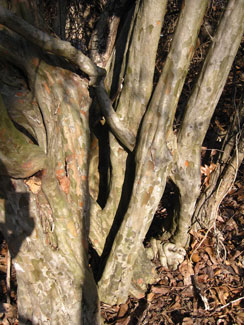Resource Library
Plant of the Week: Littlehip Hawthorn
The University of Arkansas System Division of Agriculture does not promote, support or recommend plants featured in "Plant of the Week." Please consult your local Extension office for plants suitable for your region.
Plant of the Week
Littlehip Hawthorn
Latin: Crataegus spathulata

Wintertime is the best season for bushwacking in Arkansas because you don’t have to worry about the ticks. A few years ago I stumbled upon a beautiful hawthorn buried in a tangle of wild grape vines on the Botanical Garden of the Ozarks grounds here in Fayetteville. The tree turned out to be littlehip hawthorn (Crataegus spathulata), one of about 18 species native in the state.
Hawthorns are a large, confused group of small understory trees belonging to the rose family that are widely distributed in North America, Asia and Europe. The species readily hybridize and, even in isolated stands, single species often display considerable tree to tree variation. This has lead to as many as 1000 published species names. Modern estimates are that the number of species is probably closer to 200 but that is just a guess.
Littlehip hawthorn is a small, usually low branched and twiggy deciduous tree that reaches 20 feet in height and spread with an umbrella shaped form. It has reddish-brown branches that support only a few inch and a half long straight spines. The leaves are small, about an inch long, spatula shaped or sometimes 3-lobed at the apex and closely resemble parsley hawthorn (C. marshallii). Both species share a similar southeastern US native range from Virginia to East Texas, including most of Arkansas.
The reason I spotted the littlehip hawthorn on that winter day was because of the beautifully exfoliating bark that forms a natural camouflage of patches of gray, orange, olive green and brown. In this really old specimen the trunk has begun to elongate lengthwise and has broken into several segments.
Littlehip hawthorn has 1/3rd inch wide, 5-petaled white flowers in dense clusters with 20 stamens. The flowers appear in mid spring are somewhat fetid smelling and often pollinated by flies. In this species the anthers atop the slender stamens are white while in the closely related parsley hawthorn the anthers are red. Both species have small, bright red, quarter inch long oblong berries (pomes) that contain several small seed. The fruit are eaten by many song birds.
It would be easier to get excited about hawthorns in landscape situations if they grew a bit faster. The ones grown as ornamentals are a bit more vigorous but the natives are impossibly slow and, because of this, seldom offered in the nursery trade. They do offer unique landscape forms and if one exists in the native landscape room should be provided for its growth. Nurseries specializing in native plants offer some of the better native species but the plants will be small and patience needed for them to achieve sufficient size to impact the landscape.
Both the littlehip hawthorn and parsley hawthorn are hardy to zone 5 and can be grown as far south as zone 9. They are best suited to partial shade in any reasonably well drained garden soil. Once established they have considerable drought tolerance. Leaf diseases such as cedar-hawthorn rust and leaf miners may mar the foliage and can slow the growth of the plant but are not sufficiently problematic to warrant control remedies.
By: Gerald Klingaman, retired
Retired Extension Horticulturist - Ornamentals
Extension News - March 29, 2013
The University of Arkansas System Division of Agriculture does not maintain lists of retail outlets where these plants can be purchased. Please check your local nursery or other retail outlets to ask about the availability of these plants for your growing area.